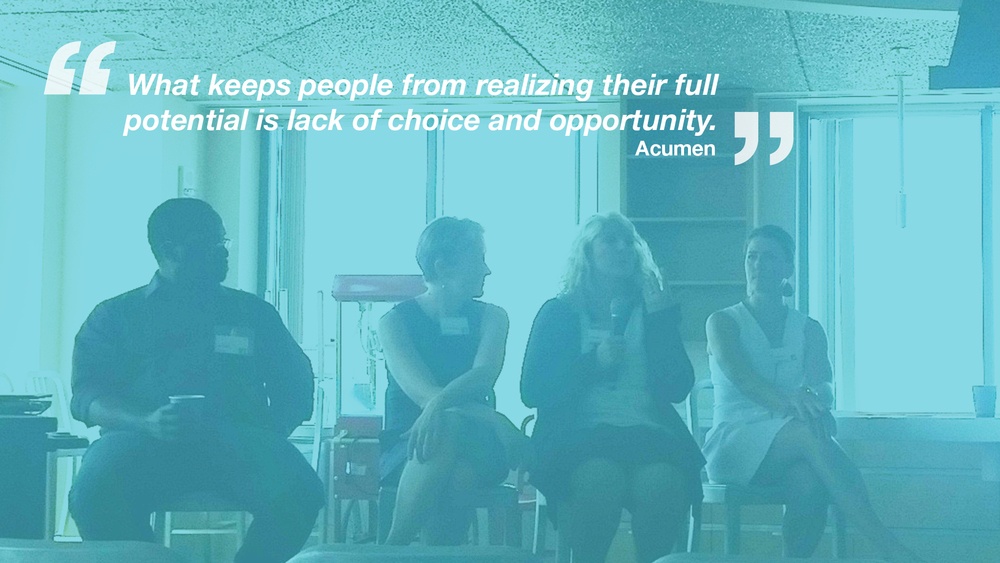
Designers have the expertise essential for driving social innovation.
As a researcher with Master’s in Design for Sustainability, “Design for Social Innovation” has always been a huge part of my personal and professional life. My work is inspired by field leaders like Victor Papanek and Victor Margolin. Last week, I had the pleasure of attending an event “Learn. Leverage. Lead.” sponsored by Boston+Acumen. Thought leaders from different social impact fields shared their expertise around tackling poverty through solutions that involve mobilizing systems and investing in leaders.
Eleanor Murphy, Business Development Manager from Acumen, kicked off the event by presenting Acumen’s approach and grassroots efforts towards supporting and scaling early-stage companies who tackle poverty. She illustrated how Acumen invests in financial and human capital, technical assistance, and strategic guidance with platforms in different sectors, such as housing, energy, education, and healthcare. Acumen also provides education and leadership through online and fellowship programs. Such training is focused on developing moral imagination, operational, and financial skills. Since these skills are taught in the design thinking approach, designers are in a unique position to play a more significant role enacting social change.
Eleanor was joined by panelists from Days for Girls, Ashoka, and Sproxil for a discussion that was the highlight of the event. These inspiring experts communicated their passion and energy to the audience. The conversations revolved around communicating missions, finding apt partnerships, growing strong partnerships, and developing the skills necessary to become a successful social entrepreneur including the ability to articulate challenges faced and lessons learned.
Over the course of the discussion one central theme emerged; social problems are not scalable. Each problem is unique and requires a reexamination of assumptions. Ashifi Gogo, the CEO and Founder of Sproxil, award-winning Mobile Product Authentication (MPA) technology, emphasized the power of storytelling in maintaining strong relationships among team members. While involved in a project, sharing stories of failure and success with transparency and authenticity boosts confidence and trust between involved stakeholders.
The complex and chaotic nature of social problems demands a flexible approach and a degree of openness to working with ambiguity. By leveraging their creative problem solving, systems thinking, and storytelling skills, designers can act as a catalyst for social change. The design thinking approach supports questioning the status quo, challenging established norms, disrupting the current system, defining the bigger picture, and identifying the details that make up the bigger picture. This approach empowers a team to connect the dots and create sustainable, innovative solutions.
The combination of increasing customer awareness and cultural, economic, and technological trends are pushing brands to think differently. Leading brands maintain their relevance to customers and their current and future competitive edge in the marketplace by placing extensive effort on developing brand sustainability. By examining brand pioneers like Unilever, BMW, and Nike, we see a shift towards meeting customers’ needs by adopting a triple bottom line approach and investing in social equity. This comment by Fernande Raine, Senior Changeleader from Ashoka, really resonated with me: The fact that today, compared to 15 years ago, we have these conversations around brand social responsibility is a proof for a necessity of the topic and the increasing awareness and popularity around it.
In the afternoon, I attended a storytelling workshop by Liz Callanhan from the Ariel group about the “Leadership Presence”. According to Liz, presence can be achieved through being present, reaching out, having self-knowledge, and expressiveness. Storytelling has always been part of my career and empowers me to connect with my audience by capturing their attention and empathy. It was inspiring to meet Liz and learn about her approach. Liz pushed us to reflect on our values and authenticity, and connect to our core motivations in advocating for social impact with techniques, such as using the present tense, expressing our emotions, and visualizing the context.
In recent years the responsibility of the designer, like many other disciplines that address complex societal challenges like poverty and hunger, has increased and spread from community-level to a grander, global scale. In addition, corporations and entrepreneurs view social innovation as an integral component of their business. Through strategizing, visualizing, prototyping, and iterating, designers can partner with NGOs and corporations to create resilient future communities. Companies can leverage human-centered design thinking not only to thrive from a business standpoint, but also to invest in social innovation, and enhance customer loyalty.


